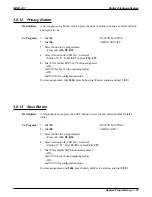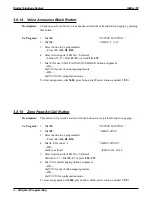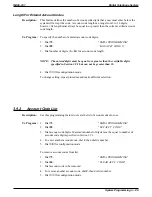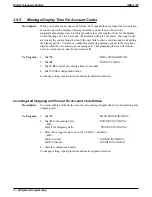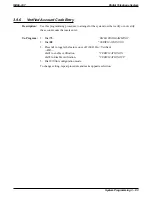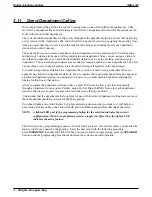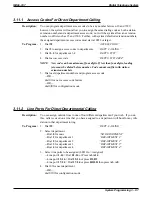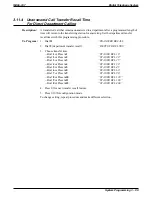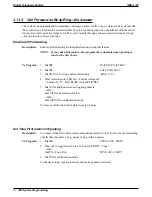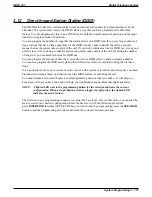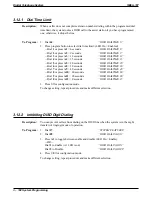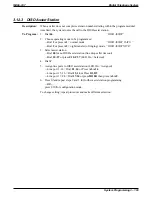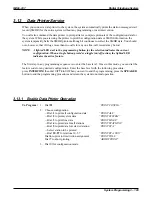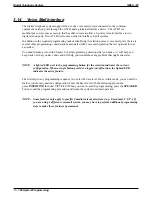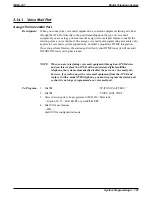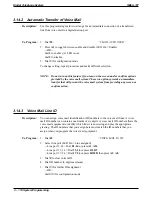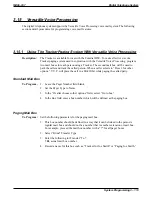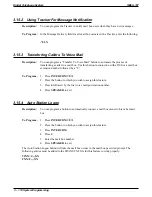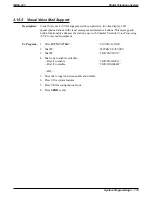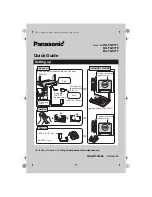
3.12
Direct Inward Station Dialing (DISD)
The DISD feature allows an external party to call an intercom station directly without assistance by the
attendant. The system must receive the DISD call on a line that you have programmed to allow this
feature. You can program any line to be a DISD line for both the normal mode of operation and the night
transfer (of ringing) mode of operation.
You can program the number of rings that the system allows on a DISD line. If you set a large number of
rings, stations that have a line appearance for the DISD line have time to handle the call in a regular
manner before the system takes control of the call. If you wish to dedicate a line for DISD use, it is a good
practice to set it for one ring so that the system can quickly take control of the call. By setting the number
of rings to 0, you can disable the line for DISD use.
You can program the amount of time the system allows for a DISD caller to dial an extension number.
You can also program the DISD assist station that will answer calls not completed during the dial time
limit.
It is a good practice for you to connect a music source to the system to let callers know they have not been
disconnected during a camp-on situation when the DISD feature is controlling the call.
You should make a record in Chapter 4 of all programming decisions that you make—it will help you
keep track of what you have done and will help you troubleshoot any problem that might arise later.
NOTE: A lighted LED next to the programming button for the selection indicates the current
configuration. When a single button provides a toggle (on/off) action, the lighted LED
indicates the active feature.
The first step in any programming sequence is to enter the base level. Once in this mode, you can dial the
feature code for any desired configuration. Enter the base level with the following procedure:
press INTERCOM then dial
✳
# 7 4 6
✳
. When you want to end the programming, press the SPEAKER
button to end the programming procedure and return the system to normal operation.
IMI66–107
Digital Telephone System
System Programming 3 – 101
Summary of Contents for Air Impact DSU
Page 2: ...Printed in U S A GCA47 157 ...
Page 30: ......
Page 112: ......
Page 192: ...Digital Telephone System IMI66 107 3 80 System Programming ...
Page 283: ......
Page 284: ......
Page 285: ......
Page 286: ......
Page 287: ......
Page 288: ......
Page 289: ......
Page 290: ......
Page 291: ......
Page 292: ......
Page 293: ......
Page 294: ......
Page 295: ......
Page 296: ......
Page 297: ......
Page 298: ......
Page 299: ......
Page 300: ......
Page 301: ......
Page 302: ......
Page 303: ......
Page 304: ......
Page 305: ......
Page 306: ......
Page 307: ......
Page 308: ......
Page 309: ......
Page 310: ......
Page 311: ......
Page 312: ......
Page 313: ......
Page 314: ......
Page 315: ......
Page 316: ......
Page 317: ......
Page 318: ......
Page 319: ......
Page 320: ......
Page 321: ......
Page 322: ......
Page 323: ......
Page 324: ......
Page 325: ......
Page 326: ......
Page 327: ......
Page 328: ......
Page 329: ......
Page 330: ......
Page 331: ......
Page 332: ......
Page 333: ......
Page 334: ......
Page 335: ......
Page 336: ......
Page 337: ......
Page 338: ......
Page 339: ......
Page 340: ......
Page 431: ......
Page 436: ......
Page 437: ......
Page 438: ......

